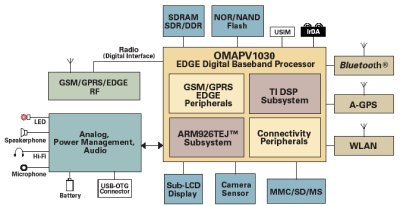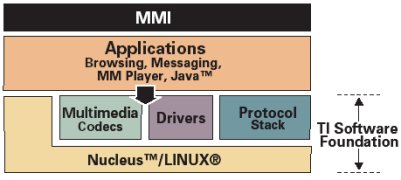Reference design targets Linux at midrange mobile phones
Feb 15, 2005 — by LinuxDevices Staff — from the LinuxDevices Archive — viewsTexas Instruments is sampling a new OMAP broadband processor and chipset for midrange mobile phones, along with a single-board reference design that includes an embedded Linux software stack, as well as Java acceleration support. The TI OMAPV1030 for GSM/GPRS/EDGE applications aims to deliver advanced multimedia capabilities to mass-market wireless devices at low cost. It is the first offering in a new TI family of OMAP-Vox platforms, which the company says gives manufacturers a “natural roadmap” from GSM/GPRS/EDGE to UMTS, enabling “seamless” software migration from 2.5G to 3G “and beyond.”
Based on an advanced 90-nm CMOS process, the OMAP broadband processors combine an ARM926TEJ processor with a TI DSP and have gained a leadership position at the high end of the mobile phone market. The highly integrated OMAPV1030 is based on the OMAP1710 architecture and includes GSM/GPRS/EDGE peripherals and connectivity peripherals for such interfaces as Bluetooth, Wireless LAN, and A-GPS. The processor runs both modem and other applications on the same core by sharing hardware resources, making a multimedia coprocessor unnecessary.
The chipset provided on the reference board (see figure below) contains a single-chip analog device that combines power management, audio codecs and drivers for AAC and AAC+, MP3, and MIDI 64. It also supports video capture, playback and streaming at a minimum of 30 frames/second for QCIF size images; digital still cameras with up to 2 Megapixels; dual LCDs; and MPEG4/W-AMR decoding at 15 frames/second for images with up to CIF format.

OMAPV1030 hardware architecture for GSM/GPRS/EDGE
(Click image for larger view)
Software support provided by the OMAPV1030 reference design includes a field-tested GSM/GPRS/EDGE protocol stack, drivers, multimedia codecs and functions, plus a suite of development tools for embedded Linux and Nucleus (see figure below). The reference design can also run on Windows Mobile and Symbian OS, according to TI.

OMAPV1030 software for GSM/GPRS/EDGE solutions
Volume production of the OMAPV1030 chipset is expected in Q3 2005.
This article was originally published on LinuxDevices.com and has been donated to the open source community by QuinStreet Inc. Please visit LinuxToday.com for up-to-date news and articles about Linux and open source.